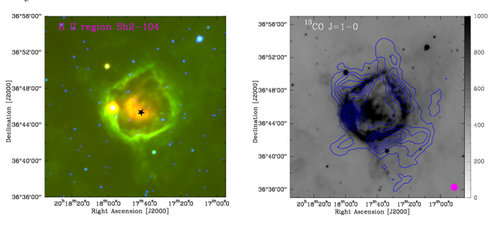Jin-Long Xu, a researcher from National Astronomical Observatories of CAS (NAOC), and his team use the Qinghai Station of Purple Mountain Observatory 13.7 m telescope, Herschel, WISE and other multi-bands data to study HII region SH2-104 in detail, and first reveal that the molecular gas surrounding SH2-104 is a two-dimensional sheet. The research achievement has been published in the international astronomical journal (ApJ) recently. The collaborators of the article include researcher Ye Xu from Purple Mountain Observatory of CAS (PMO) et al.
The partially ionized hydrogen regions (H II Regions) are produced by the UV photons produced by massive stars to ionize the surrounding medium. Stars form in molecular clouds, and the H II regions also form and evolve in molecular clouds. All the true celestial objects show three-dimensional structures, and then the medium around the spherical H II region will also exhibit a three-dimensional structure. Based on the analysis of the structure and dynamics of the surrounding medium around HII region SH2-104, the researchers find that the medium around the H II region is a circular two-dimensional structure, not a spherical shell of the three-dimensional structure. Interestingly, why the molecular gas around the three-dimensional H II region is two-dimensional ring-like structure, and the center of the annular structure is empty without the corresponding molecular gas radiation. Through the study of the series of articles, it has been revealed that the partial interstellar medium in the Milky Way is a two-dimensional sheet with a certain thickness. When the scale of the expanding HII region is larger than that of the surrounding medium, it shows the two-dimensional structure around SH2-104.
Since 2009, APEX and Herschel have completed the dust-continuum survey, revealing that the medium in the Galaxy is filamentary, but the researchers also reveal that the two-dimensional sheet-like structure exists in the interstellar medium. The lateral projection (face-off) of the sheet-like structure can also show the filamentary structure, suggesting that the filament detected in the Galaxy is also the projection of some two-dimensional sheet-like structures in line of sight. The detection of the sheet-like medium will bring new challenges to the study of how stars are formed. In addition, some massive main-sequence stars and late stage supernovae in the Milky Way also probably evolve and explode in a two-dimensional structure medium. The submillimeter telescope CCOSMA located in Yangbajin of Tibet will be put into operation, and will also be an important role to study the structure of the interstellar medium and star formation.

Left: The PAHs emission map (green color) around H II region SH2-104. The black star represent the excited star of the H II region (O6V). Right: the 13CO J=1-0 emission map (blue contours) around H II region SH2-104.

Address: 20A Datun Road, Chaoyang District, Beijing, China code: 100012
Tel: 010-64888708 E-mail: naoc@nao.cas.cn

